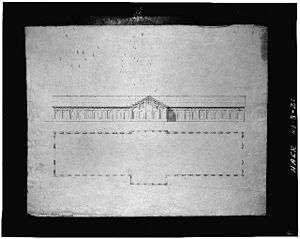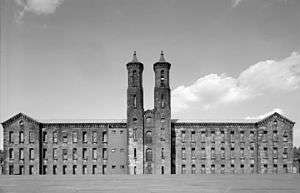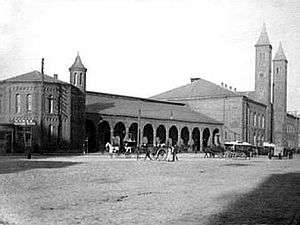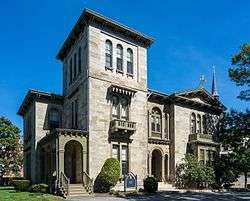Thomas Alexander Tefft
Thomas Alexander Tefft (August 2, 1826 – December 12, 1859) was an American architect, from Providence, Rhode Island.
Thomas Alexander Tefft | |
|---|---|
 Thomas Alexander Tefft | |
| Born | August 2, 1826 |
| Died | December 12, 1859 (aged 33) |
| Nationality | American |
| Alma mater | Brown University |
| Occupation | Architect |
| Buildings | Cannelton Cotton Mill Narragansett Baptist Church Providence Union Railroad Depot (1847–1896) |



Life and career
Tefft was born in rural Richmond, Rhode Island, outside of the small village of Wood River Junction. He was the fourth child of William C. and Sarah Tefft. His family worshiped at the Richmond Six-Principle Baptist Church. As a young man, he began teaching in the District No. 5 School at Quarrelsome Corners.[1]
During the 1840s the state school commissioner, Henry Barnard, embarked on an inspection of the state's public schools. Noting Tefft's talents for drawing and the other arts, Barnard convinced him to move to Providence and study architecture. He entered the office of Tallman & Bucklin, then one of the city's primary offices. By 1846 he was doing most of the designing for the firm. At this time he also enrolled in Brown University.[2]
In 1851, Tefft graduated from Brown. At the same time, the partnership of Tallman & Bucklin was dissolved. Tefft then opened his own office, and ran a notable practice that lasted only five years. In 1856 he decided to embark on a grand tour of Europe. Due to the beginning of an economic downturn, the only work that Tefft had in his office were the initial designs of Vassar College. With that project stagnating, he chose to go. He departed on the steamer Arago on December 13, 1856.[3]
He began in England, where he studied the works of Sir Christopher Wren, among others. He also met and was entertained in the home of noted architect Sir Charles Barry. He also visited the cities of Paris, Rome, Geneva, Berlin, Milan, and Florence, among others.[4] In December 1859 he fell ill with a fever in Florence at the home of his friend, the sculptor Hiram Powers. He died there on the 12th. He was first buried in the English Cemetery in Florence. In February 1860 his body was shipped back to Rhode Island, where it was re-interred in Swan Point Cemetery.[5]
Works
With Tallman & Bucklin, 1846–1851:
- Lawrence Hall, Williams College, Williamstown, MA (1846–47) – Built as the library.[6]
- Barrington School, 351 Nayatt Road, Barrington, RI (1840).[7]
- Butler Hospital, 345 Blackstone Blvd., Providence, RI (1847) – The original design has been obscured by later additions.[8]
- Elisha Dyer House, 11 Greene St., Providence, RI (1847) – Demolished.[9]
- Freight House No. 1, Canal St. at Elizabeth, Providence, RI (1847–48) – Served as the passenger station until Union Station was completed. Demolished.[10]
- Gatehouse, Swan Point Cemetery, 585 Blackstone Blvd., Providence, RI (1847) – Demolished.[11]
- Receiving Vault, Swan Point Cemetery, 585 Blackstone Blvd., Providence, RI (1847)[12]
- Second Universalist Church, 151 Weybosset St., Providence, RI (1847–49) – Burned in 2006.[13]
- St. Paul's Episcopal Church, 55 Main St., Wickford, RI (1847)[14]
- Warren High School, 10 Liberty St., Warren, RI (1847)[15]
- Allendale School, 545 Woonasquatucket Ave., Allendale, RI (1848)[16]
- Centerdale School, Thomas St., Centerdale, RI (1848) – Demolished.[17]
- Howard's Block, 171 Westminster St., Providence, RI (1848) – Burned in 1853.[18]
- Providence Union Station, Kennedy Plz., Providence, RI (1848) – Burned in 1896.[19]
- Remodeling of House for Richard James Arnold, 124 S. Main St., Providence, RI (1848) – This house was once the Sabin Tavern, where the Gaspée Affair was planned. Demolished in 1891.[20]
- Union High and Grammar School, 60 High School St., Woonsocket, RI (1848–49) – Burned in 1875.[21][22]
- Young Ladies' High School, 235 Benefit St., Providence, RI (1848)[23]
- Indiana Cotton Mills, 310 Washington St., Cannelton, IN (1849–50) – Now the Cotton Mill Apartments.[24]
- Menzies Sweet House, 12 Arnold St., Providence, RI (1850)[25]
- Narragansett Baptist Church, 170 S. Ferry Rd., South Ferry, RI (1850)
- Pastors' Rest Monument, Swan Point Cemetery, 585 Blackstone Blvd., Providence, RI (1850)[26]
- Remodeling of the Rhode Island State House, 150 Benefit St., Providence, RI (1850)[27]
In private practice, 1851–1856:
- New England Screw Co., 1 Henderson St., Providence, RI (c.1851) – Demolished.[28]
- Paris Hill House, 201 Washington St., Providence, RI (1851) – Later the home of the Union Club of Providence. Demolished in 1915.[29]
- St. Thomas Episcopal Church, 1 Smith Ave., Greenville, RI (1851) – Tower added in 1891.[30]
- American Antiquarian Society, 185 Salisbury St., Worcester, MA (1852) – Demolished in 1909.[31]
- Gatehouse, Butler Hospital, 345 Blackstone Blvd., Providence, RI (1852) – Demolished.[32]
- Taunton Bank Building, 9 Taunton Green, Taunton, MA (1852) – Altered.[33]
- Wakefield Baptist Church, 236 Main St., Wakefield, RI (1852)[34]
- Weeden Block, 41 Westminster St., Providence, RI (c.1852) – Demolished.[35]
- Edward Pearce House, 2 Benevolent St., Providence, RI (1853) – Demolished by the Hope Club for a parking lot.[36]
- Emily Harper House, 80 Ocean Ave., Newport, RI (1853) – Greatly expanded in the 1870s, Demolished in 1966.[37]
- Howard Block, 171 Westminster St., Providence, RI (1853) – Burned in 1858.[38]
- John B. Palmer House, 151 Waterman St., Providence, RI (1853) – Demolished in 1961.[39]
- Joseph B. Tompkins House, 38 Catherine St., Newport, RI (1853)[40]
- Oakwoods, Oakwoods Dr., Peace Dale, RI (1853) – The home of Rowland Hazard. Demolished.[41]
- Quatrel, 669 Bellevue Ave., Newport, RI (1853–54) – For Earl P. Mason.[42]
- South Baptist Church, 125 Main St., Hartford, CT (1853–54) – Demolished in 1926.[43]
- Tully D. Bowen House, 389 Benefit St., Providence, RI (1853)[44]
- First Baptist Church, 212 S. Washington St., Alexandria, VA (1854) – Greatly altered.[45]
- Henry E. Russell House, Lake St. & Grove Hill, New Britain, CT (1854) – Demolished.[46]
- Richmond College, Grace St., Richmond, VA (1854–55) – Only one wing was ever built to Tefft's design, the rest deviated from his plan. Demolished.[47]
- Richmond Female Institute, N. 10th & E. Marshall Sts., Richmond, VA (1854) – Demolished in 1924.[48]
- Robert Lippitt House, 193 Hope St., Providence, RI (1854)[49]
- William Slater House, Halliwell Blvd., Slatersville, RI (1854) – Demolished.[50]
- Charles Potter House, 154 Waterman St., Providence, RI (1855) – Remodeled c.1900.[51]
- Charles S. Bradley House, 249 Eaton St., Providence, RI (1855) – Now Providence College's Martin Hall.[52]
- Elmhurst, 700 Smith St., Providence, RI (1855) – A house for William Grosvenor that lent the neighborhood its name. Burned in 1967.[53]
- John Carter Brown II Stable, 357 Benevolent St., Providence, RI (1855)[54]
- Proposal for Providence City Hall, 25 Dorrance St., Providence, RI (1855) – Not built.[55]
- Roger Williams Free Baptist Church, 1076 Westminster St., Providence, RI (1855) – Demolished.[56][57]
- Bank of North America Building, 48 Weybosset St., Providence, RI (1856) – Ground floor altered.[58]
- Central Baptist Church, Weybosset St. at Empire, Providence, RI (1856) – Demolished in 1915 for the new Empire Street.[59]
- Proposal for Providence Merchants Exchange Building, 76 Westminster St., Providence, RI (1856) – An unusual circular building, not built.[60]
- Proposal for Vassar College, Poughkeepsie, NY – Not built due to economic troubles. The commission would later go to Renwick, Auchmuty & Sands of New York.[61]
- Seth Padelford Stable, 17 Benevolent St., Providence, RI (1856) – Demolished in 1955.[62]
Gallery
 School House (1840), Barrington RI
School House (1840), Barrington RI- Cannelton Cotton Mill, Cannelton, Ind.
 Martin Hall, Providence College, originally the George M. Bradley House
Martin Hall, Providence College, originally the George M. Bradley House_side.jpg) Narragansett Baptist Church, originally South Ferry Church, Narraganset, R.I.
Narragansett Baptist Church, originally South Ferry Church, Narraganset, R.I. Freight House, Providence and Worcester Railroad, Providence, R.I.
Freight House, Providence and Worcester Railroad, Providence, R.I.- Tully Bowen House, Providence, R.I.
 Edward Pearce House, Providence, R.I.
Edward Pearce House, Providence, R.I. Charles Potter House, Providence, R.I.
Charles Potter House, Providence, R.I.
References
- http://ecologyofculture.blogspot.com/2010/09/was-tefft-coming-back.html
- http://ecologyofculture.blogspot.com/2010/09/was-tefft-coming-back.html
- The Architect and Monetarian: A Brief Memoir of Thomas Alexander Tefft (Edwin Martin Stone, 1869)
- The Architect and Monetarian: A Brief Memoir of Thomas Alexander Tefft (Edwin Martin Stone, 1869)
- http://ecologyofculture.blogspot.com/2010/09/was-tefft-coming-back.html
- Page 43, American Dreams: American Art to 1950 in the Williams College Museum of Art (Nancy Mowll Mathews, 2011)
- Thomas Alexander Tefft architectural drawings, Hay Archives MS-1U-T3, John Hay Library, Brown University
- Page 362, The Grove Encyclopedia of American Art, Vol. 2 (Joan Marter, ed., 2011)
- Page 102, Transactions of the Rhode Island Society for the Encouragement of Domestic Industry in the Year 1859 (1860)
- https://www.loc.gov/pictures/collection/hh/item/ri0345/
- http://www.lahistoryarchive.org/resources/SWAN_POINT/timeline.html
- http://www.lahistoryarchive.org/resources/SWAN_POINT/timeline.html
- Page 243, Providence: A Citywide Survey of Historic Resources (Wm. McKenzie Woodward, 1986)
- St. Paul's Church NRHP Nomination
- Request for Proposals: Liberty Street School
- Page 99, Proceedings of the Rhode Island Historical Society, 1873–74 (1874)
- Page 99, Proceedings of the Rhode Island Historical Society, 1873–74 (1874)
- Sheila Lennon (January 25, 2013). "Long ago, it housed a business school: Where, when, what's there now?". The Providence Journal. Retrieved 2014-12-22.
- Page 102, Providence: A Citywide Survey of Historic Resources (Wm. McKenzie Woodward, 1986)
- Page 112, North by South: The Two Lives of Richard James Arnold (Charles Hoffmann and Tess Hoffmann, 1988)
- Richardson, Erastus. History of Woonsocket. 1876.
- Barnard, Henry. School Architecture. 1850.
- "Archived copy". Archived from the original on 2014-12-09. Retrieved 2014-12-06.CS1 maint: archived copy as title (link)
- Page 313, The Life and Times of Francis Cabot Lowell, 1775–1817 (Chaim M. Rosenberg, 2011)
- Page 137, Providence: A Citywide Survey of Historic Resources (Wm. McKenzie Woodward, 1986)
- http://swanpointcemetery.com/art-architecture.php
- Page 142, Providence: A Citywide Survey of Historic Resources (Wm. McKenzie Woodward, 1986)
- Tefft drawings at Brown University
- Tefft drawings at Brown University
- Page 60, Historic and Architectural Resources of Smithfield, Rhode Island (RIHPC, 1992)
- "Worcester Antiquarian Society", Norton's Literary Gazette (November 15, 1852)
- Tefft drawings at Brown University
- https://repository.library.brown.edu/studio/item/bdr:204626/
- Page 381, Buildings of Rhode Island (William H. Jordy, 2004)
- https://repository.library.brown.edu/studio/item/bdr:204727/
- https://www.loc.gov/pictures/item/ri0234/
- Tefft drawings at Brown University
- "Long ago, it housed a business school: Where, when, what's there now?", Providence Journal (January 25, 2013)
- Page 167, Providence: A Citywide Survey of Historic Resources (Wm. McKenzie Woodward, 1986)
- Page 216, Newport Through its Architecture (James L. Yarnall, 2005)
- Tefft drawings at Brown University
- Page 216, Newport Through its Architecture (James L. Yarnall, 2005)
- https://repository.library.brown.edu/studio/item/bdr:205664/
- Page 145, Providence: A Citywide Survey of Historic Resources (Wm. McKenzie Woodward, 1986)
- Page 85, Buildings of Virginia (Richard Guy Wilson, 2002)
- https://repository.library.brown.edu/studio/item/bdr:204796/
- Page 151, Virginia Baptist Ministers, Vol. 3 (George Braxton Taylor, 1912)
- http://www.rosegill.com/ProjectWinkie/Old%20Richmond%20Neighborhoods.pdf
- Page 188, Providence: A Citywide Survey of Historic Resources (Wm. McKenzie Woodward, 1986)
- Tefft drawings at Brown University
- Page 235, Providence: A Citywide Survey of Historic Resources (Wm. McKenzie Woodward, 1986)
- Page 174, Providence: A Citywide Survey of Historic Resources (Wm. McKenzie Woodward, 1986)
- Page 78, Providence: A Citywide Survey of Historic Resources (Wm. McKenzie Woodward, 1986)
- Page 144, Providence: A Citywide Survey of Historic Resources (Wm. McKenzie Woodward, 1986)
- Pages 122 & 153, Buildings on Paper: Rhode Island Architectural Drawings, 1825–1945 (William H. Jordy and Christopher P. Monkhouse, 1982)
- https://repository.library.brown.edu/studio/item/bdr:205672/
- Page 147, The Providence Plantations for 250 Years (Welcome Arnold Greene, 1886)
- Page 243, Providence: A Citywide Survey of Historic Resources (Wm. McKenzie Woodward, 1986)
- Page 118, Providence: A Citywide Survey of Historic Resources (Wm. McKenzie Woodward, 1986)
- Pages 171–172, Buildings on Paper: Rhode Island Architectural Drawings, 1825–1945 (William H. Jordy and Christopher P. Monkhouse, 1982)
- Page 31, Alma Mater: Design and Experience in the Women's Colleges (Helen Lefkowitz Horowitz, 1984)
- Page 169, Buildings on Paper: Rhode Island Architectural Drawings, 1825–1945 (William H. Jordy and Christopher P. Monkhouse, 1982)
External links
- The Architect and Monetarian: A Brief Memoir of Thomas Alexander Tefft by Edward Martin Stone (1869). Full text. Retrieved 9 December 2014.
- Thomas Alexander Tefft: Architect Extraordinaire. Retrieved 9 December 2014.
- Thomas Alexander Tefft at Find a Grave